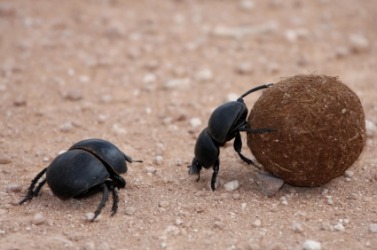 If by any chance you read the earlier blog, "Revised, My Favorites in this Order," you'll know that dung beetles are among my favorite living creatures. Imagine my delight when I discovered right there on my desktop a document called Dung Beetle Facts - a forgotten remnant left over from a school report that Quince had to do months ago, long before I decided that these little unassuming creatures ranked in my top 5. Personally, I think you would be well advised to stash a few of these little facts in your pocket, because at the right moment you'll get to pull one of these little gem pebbles out, drop it in a conversation and watch the ripples. . .
If by any chance you read the earlier blog, "Revised, My Favorites in this Order," you'll know that dung beetles are among my favorite living creatures. Imagine my delight when I discovered right there on my desktop a document called Dung Beetle Facts - a forgotten remnant left over from a school report that Quince had to do months ago, long before I decided that these little unassuming creatures ranked in my top 5. Personally, I think you would be well advised to stash a few of these little facts in your pocket, because at the right moment you'll get to pull one of these little gem pebbles out, drop it in a conversation and watch the ripples. . . PS. If you read all the way to the bottom, there is a special little surprise.
Facts about Dung Beetles
These are the fact you relate if you
want to sound smart and sciencey and like an entomologist. Skip this first set if you are actually in need of something that will hold the crowd.
- There are thousands of species, or kinds, of dung beetles. Wherever there is dung, there are most likely dung beetles. Dung beetles are found worldwide, on every continent except Antarctica. They live in habitats that range from desert to forest.
- Dung beetles range from a length of 0.04 inches (1 millimeter) to 2.4 inches (6 centimeters).
- A dung beetle can live up to three years.
- Most dung beetles are dark colored. Some are shiny metallic colors. Others have bright patterns.
- Dung beetles have wings and can fly. Their six legs are made for rolling dung and digging holes.
Cocktail party facts:
- When an animal such as an elephant chews, swallows, and digests, there are always parts of its meal that pass through undigested. Those undigested bits pass out of the animal in its dung—and that is what provides food for dung beetles
- Some species of dung beetle use their sense of smell to find animal droppings. Other species hitch a ride on their animal of choice. They wait until the creature poops then the beetles hop off, and dinner is served!
- On a busy night, one dung beetle can bury 250 times its own weight in dung.
- A scarab that was worshipped in ancient Egypt is actually a type of dung beetle.
- In parts of Texas, dung beetles bury about 80 percent of cattle dung.
- As a dung beetle rolls its ball of dung, other dung beetles will often try to steal it.
Facts to impress the 10 and under set.
- Dung beetles belong to three basic groups: rollers, tunnelers, and dwellers. Those words describe how these beetles use the dung they find.
- Rollers shape pieces of dung into balls and roll them away from the pile. They bury their ball to either munch on later or to use as a place to lay their eggs.
Tunnelers bury their dung treasure
by tunneling underneath the pile.
And dwellers actually live inside
dung piles. (charming)
- Dung beetle larvae, or young, eat the solid dung while adult dung beetles stick to liquids. There is a good bit of nutritious moisture in dung, and adult beetles suck up that juice.
I shall certainly try some of this fascinating information at my next (and last) cocktail party....after a few glasses of red wine.
ReplyDelete